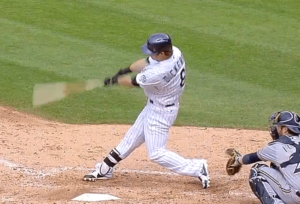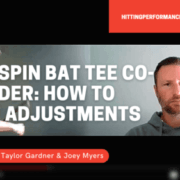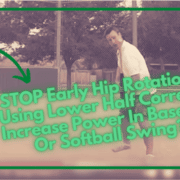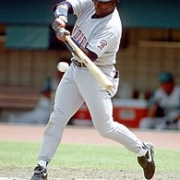Corey Dickerson VIDEO: #1 Most Critical Hitting Position
Corey Dickerson: 3 Human Movement Laws That Dominate
I wanted to analyze a young lefty slugging Colorado Rockies outfielder by the name of Corey Dickerson. Standing and weighing in at 6-foot, 1 inch, and 205 pounds, Dickerson isn’t a big guy by today’s standards. And comparing key offensive indicators (photo on right), puts him in decent company…
FanGraphs.com says this about OPS & OPS+:
“OPS is the widely used metric measuring a hitter’s contact, patience, and and power. Since OPS+ adjusts for league and park effects, it’s possible to use OPS+ to compare players from different years and on different teams.”
How efficiently a hitter gets into their Fight (landing) Position can dramatically effect their OPS and OPS+. In analyzing Corey Dickerson swing, we’ll see how he uses THREE scientifically proven human movement laws to dominate his Fight Position:
- Gravitational Forces,
- Transferring Forward Momentum, and
- Spine engine mechanics.
We’ll also look at what repeatable power elements are missing in his swing…
Laws That Dominate #1: Gravitational Forces
Imagine standing in the middle of a trampoline. Push your body weight into the canvas by bending your knees slightly, and jump 2-inches off the surface. Now, use all your body weight, squatting down like your butt’s going to touch the canvas, and jump 2-feet in the air. Notice how pushing harder into the surface, gave you a higher jumping result?
These are Gravitational Forces at work. By pushing into the ground (trampoline canvas), the surface pushes back with an equal and opposite force. Corey Dickerson amplifies Gravitational Forces by “getting shorter” and dropping his body-weight into the earth when he lands into his Fight Position. The ground gives thanks by giving him a push back!
Following…
Laws that Dominate #2: Transferring Forward Momentum
In science, this is commonly referred to as the Conservation of Linear Momentum. In Corey Dickerson’s case, here’s how it works:
- First, he transfers his weight back and Floats (timing) before falling forward,
- He gets a swing “head start” by moving his body-weight towards the pitcher, and
- Then commits to weighting his front leg before transferring Forward into Angular (rotating) Momentum at the Final Turn.
Corey Dickerson lands with an open hip-knee-toe to set up the turning of the pelvis. His front knee is bent and stacked almost over his ankle allowing him to push into the ground (Gravitational Forces). This will make way for what’s called “Blocking” during the Final Turn. Next…
Laws that Dominate #3: Spine Engine Mechanics
Blocking the shoulders from opening too soon is critical to repeatable power. Tony Gwynn calls this “staying on the ball”. And Corey Dickerson does the basics (a la Gwynn). He’s not loading his torso’s springy material optimally. I believe he’s leaving 10% of his repeatable power on the table. Here’s how he can improve his Fight Position:
- Raise back elbow above top hand during fall, to get a more downward shoulder angle,
- Show his number to the pitcher more clearly, and
- Hide his hands from the pitcher a little better.
The Fight Position is one of THE most critical points in the swing. As you can see, Corey Dickerson uses THREE (2.5, lol) scientifically proven human movement laws before he lands his Fight Position. To me, at least 70% of hitting faults can be fixed here. Make sure you’re swinging smarter by moving better!
- Master Your Swing: How to Choose the Best Baseball Hitting Training Videos for Immediate Skill Boost - February 28, 2024
- Mastering Advanced Baseball Techniques: Personalized Online Coaching Elevates Youth & High School Hitting Skills - January 17, 2024
- Master the Art of Batting by Doing the Opposite of What You Think - January 16, 2024
















There are some great observations made here, and anyone serious about teaching hitting should pay close attention. One thing Joey has taught me recently is to be very suspicious of camera angles, but it looks to me like he’s late getting his back heel off the ground. As the player allows himself to fall forward he must walk/fall away from the back heel. One reason is because he has to start to drop his back side and elevate his front side to get on plane (as he’s rotating and without collapsing), and another reason is that the front foot turns in mid air during the stride, and it takes the leg and front hip with it. This is one of the things that starts rotation. The back heel has to accommodate/reciprocate that movement or you will create a ‘tug of war’ inside the hips. Some coaches will call this creating torque, but there is no grey area on this, and you can’t train your body not to tighten up because, like most human movement, it’s a reflex action. Not only that … but at this point the ball is already in the air, and if you create internal resistance that late you’ll hinder rotational velocity. Everything has to be working in tandem with it’s reciprocating segment, because it just happens too fast to make adjustments in fine increments.
I love it Bob! Great observation yourself. And thanks for the “leading with the front thigh” tip. Corey Dickerson probably thinks – like most others who’ve read Ted Williams’s The Science of Hitting – that you have to turn the hips inwards towards the catcher to load the body. As you know, this is false. Anyone who’s read Thomas Myers’s (no relation) book Anatomy Trains would say otherwise. Thanks again Superfly 😉
Pease explain more about what you mean by “weighting his front leg before transferring forward”
I’m sorry, did I say weighting his “front” leg or “back” one. I probably meant the latter. In other words, weighting the back leg, or shifting the weight back before going forward.
I prefer queueing hitters to “take the back hip with the fall” as I have found, at least young hitters, tend to step forward as opposed to driving forward. Like the observation of the back heel release with the fall to promote commiting the hips. All too often hitters change commitment when taking pitches. I would much rather they continue to commit lower half then decide to fire hands-torso with a yes-yes-yes or a yes-yes-no approach. Also like how he rides his back shoulder into bat turn then releases through the ball to extension. Nice to see others observing the kinematic sequencing I teach my guys.
Great observations and comments Frank! I totally agree with your cue about “taking the back hip with the fall”. Precise coaching cues are VERY important. Keep up the good work my friend 😀
Joey,
In the Catapault loading system you mention to bring front shoulder inside of front hip as a way to show the numbers. I may have missed the talk about brining up the back elbow above the top hand to assist in lowering that front shoulder. How have you cued that movement in the past? Also in the catapault loading system you talk about comfort in the initial set up before you begin loading or the “float” phase. What if the hitter doesn’t begin with the elbow up, when does that movement occur or when do you suggest it occur? Thanks.
Mario,
Good questions…yes, bring the front shoulder inside the front hip will kill two birds with one stone…showing numbers to pitcher AND downward shoulder angle. Bringing the back elbow as higher or slightly higher than the top hand will initiate downhill shoulders, yes. My main cues are:
The hitter can either start in the Catapult Loaded Position or transition into it. The transition can start anytime from when the hitter picks their front foot up, or shifts weight back, all the way to landing. The main objective with it, is to make sure the hitter is in the position just prior to landing or the Fight Position.